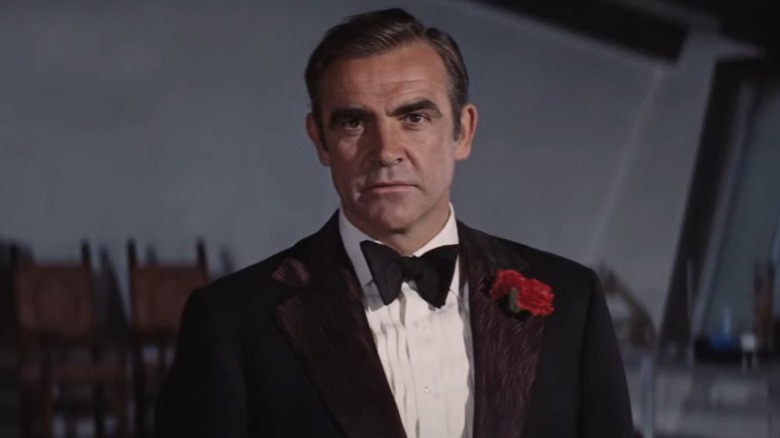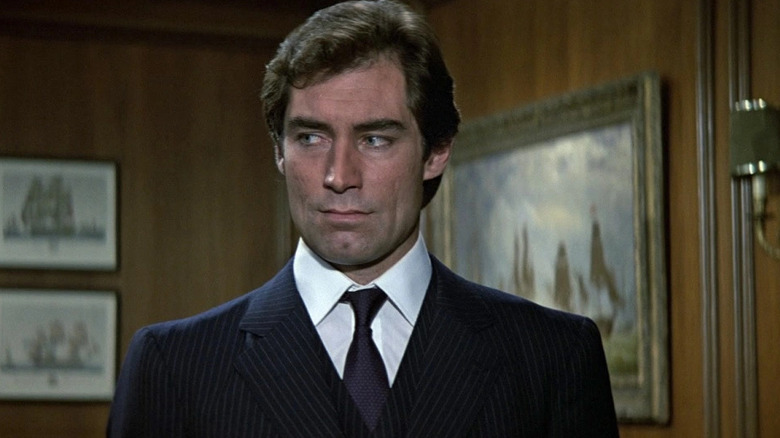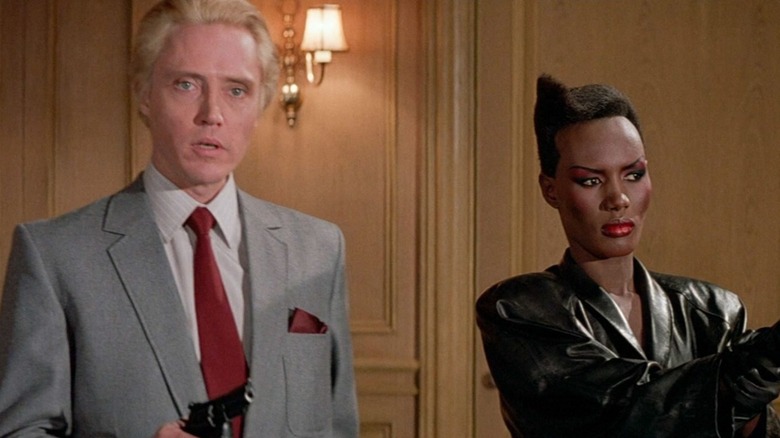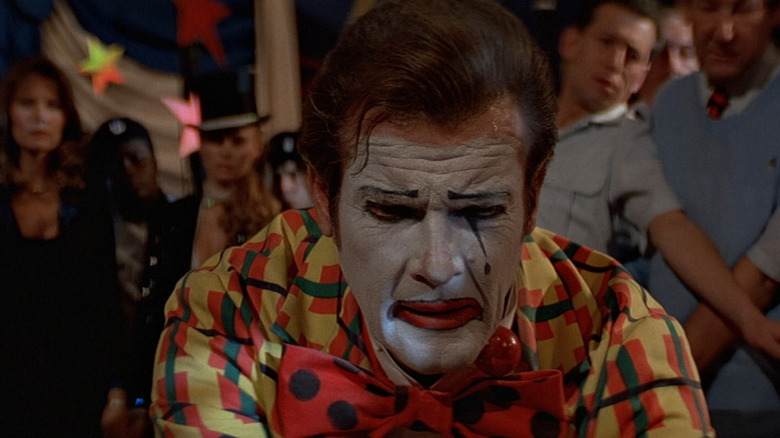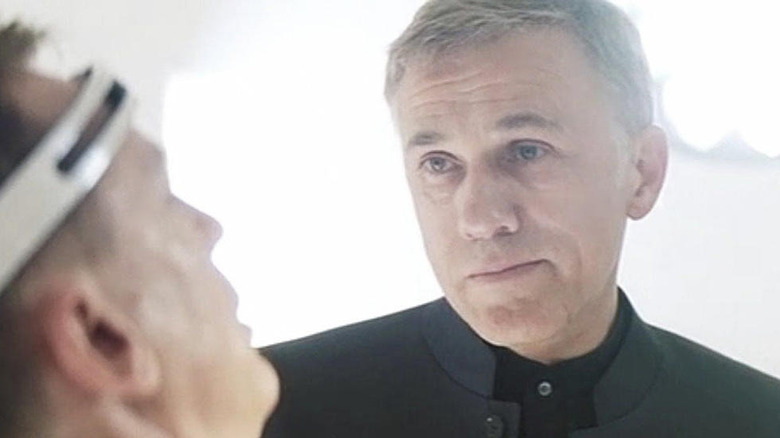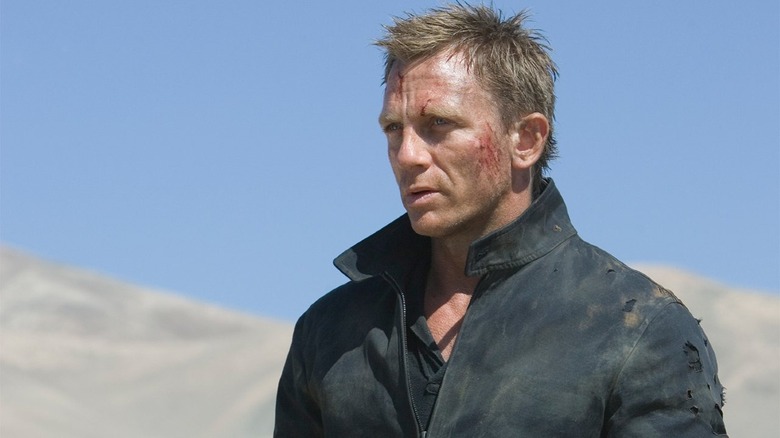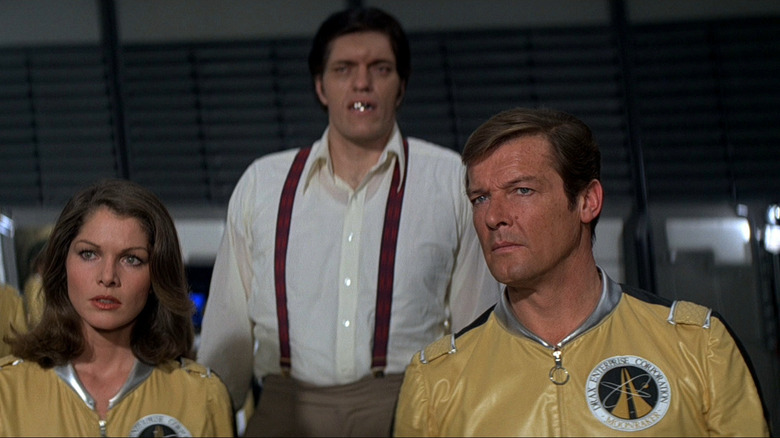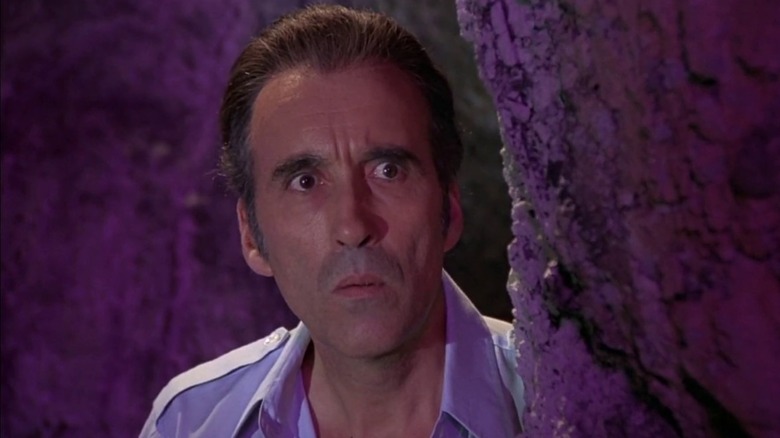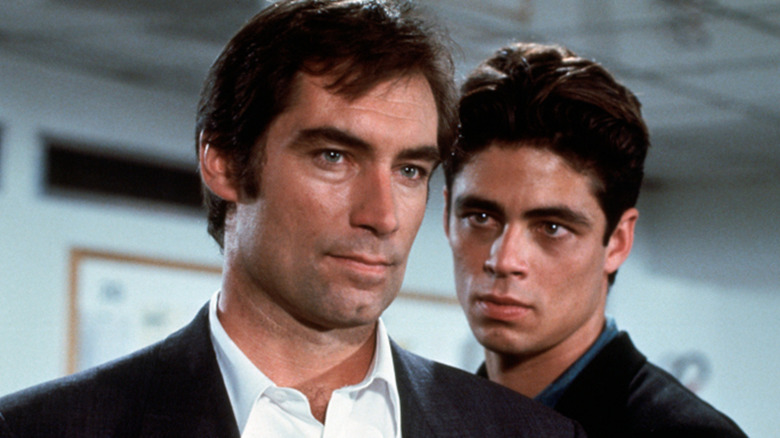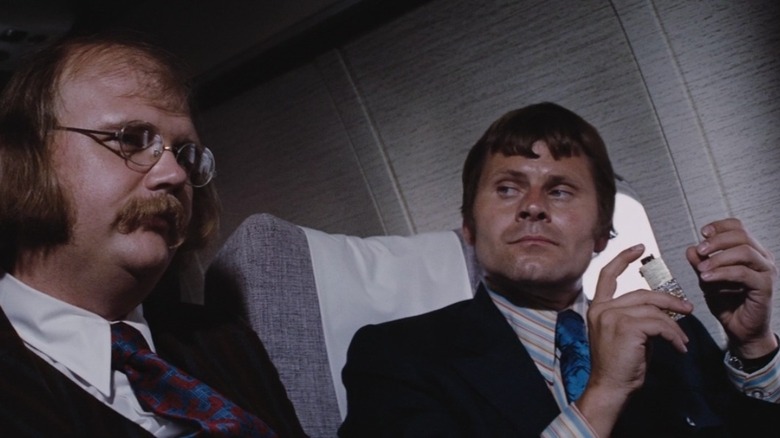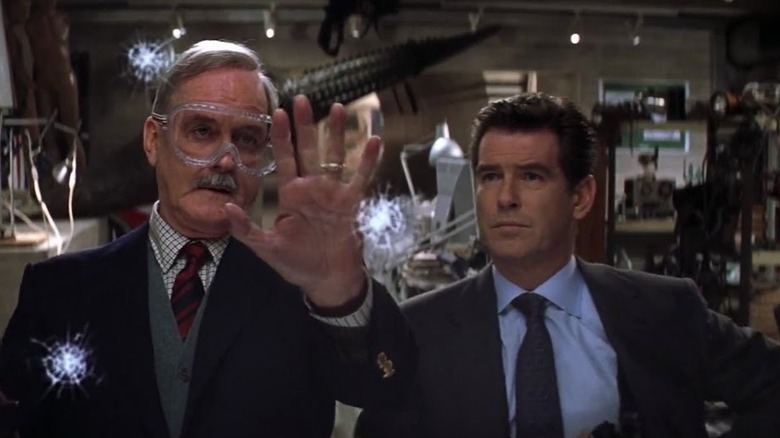10 Underrated James Bond Movies That Deserve More Respect
"On Her Majesty's Secret Service" is a movie that used to be a punchline, and the name of its star, George Lazenby, a joke. Back in the '80s, there were only two "real" choices for best Bond, and they were Roger Moore or Sean Connery. Bringing in Lazenby was like suggesting that Captain Decker could be up to Kirk or Picard standards on "Star Trek." Yet, over the years, and as more Bond films have been released, suddenly it's gaining respect again. By Rotten Tomatoes rankings, it's even a top 10 film!
Part of that reassessment is that Bond no longer feels like a choice between macho Sean Connery and knowingly corny Roger Moore. We've Seen Pierce Brosnan, Timothy Dalton, and Daniel Craig take a crack, and Lazenby's mix of Connery machismo with a bit of Moore-like humor (and a hint of tragedy) now falls better on a spectrum than into a binary. However, it also shows that time can be kind in ways we don't expect, and some Bond movies that weren't well-liked when they came out deserve re-appraisal. In many cases, it's because contemporary audiences rejected camp — like the Batman fans of the '80s dissing Adam West. Still, there's as much a place for the silly as for the serious in the adventures of a promiscuous secret agent who miraculously survives death traps and saves the world repeatedly.
With that in mind, let's reassess some of the more unfairly judged entries while being honest about why they may not be the most beloved Bond films.
10. The Living Daylights
It's cool that George Lazenby doesn't get unfairly dunked on as much anymore. It's not cool that Timothy Dalton now seems to be as divisive for many fans. After "A View to a Kill," we can hardly blame the Broccolis for going in the opposite direction of campy, past-his-prime Roger Moore. Dalton remains arguably the only Bond not to play the role as a movie star, but as a character actor. Rooted more in the Ian Fleming books, his Bond seems like a credible secret agent, and in "The Living Daylights," he gets a complicated evil plot to solve. The real-world Soviet Union was becoming less scary in real life, alienating some hardliners who could only conceive of a binary world. This time around, Bond has to bust a rogue Russian and a rogue American scamming both their governments out of money with their arms deals and covering it up with a fake story about the head of the KGB murdering all foreign agents.
Also in the real world, AIDS was becoming a major story, so Bond dropped the casual sex, staying faithful to one leading lady (Maryam d'Abo), but only after using her to get to her ex first. The one-liners stayed (as did 007's cigarettes), but with a more mordant delivery. The climactic fight on the netting hanging out of the back of a cargo plane undoubtedly inspired Tom Cruise to copycat it years later, and A-ha's theme is the second-best Bond song of all time.
9. A View to a Kill
Roger Moore gets a lot of grief for looking too old in this one, but wisely learning from "Octopussy," director John Glen limits his close-ups against a rear-projection screen during action sequences, relying more heavily on impressive stuntmen with obscured faces. As far as the rest of his performance goes, Moore has a ball with the dad jokes and banter with Patrick Macnee, who ironically seems to show up for a passing-of-the-torch moment to a Bond about to retire.
How is it that more people don't love Christopher Walken as Max Zorin? While plotting to set off a giant earthquake, he ridiculously calls attention to himself by enhancing racehorses with microchip-controlled steroids. He's psychotic because he's the product of concentration camp experiments, and he supposedly speaks five languages with "no accent," despite being, y'know, Christopher Walken. Add in Grace Jones making fierce faces as his hitwoman, May Day; the screen debut of Dolph Lundgren; a French agent named Aubergine (eggplant); and the very best Bond theme ever by Duran Duran, and you have one of the most off-the-wall adventures ever. The use of a Beach Boys cover during a Bond snowboarding scene is cringe, but can we talk about how ahead of the curve this 1985 movie was on snowboarding, base jumping, and facial recognition software?
Q's robot dog hasn't aged as well, and Tanya Roberts' inexpressive acting makes Moore look like Olivier. Still, the cut-in-half car, the Golden Gate Bridge blimp fight, Zorin's rigged horse race, c'mon. They rock.
8. Octopussy
"Octopussy" haters frequently complain that James Bond looks ridiculous infiltrating a circus disguised as a clown, having painted on perfect makeup within seconds. They're burying the lede: Bond also disguises himself as a gorilla and a crocodile (twice). That's the kind of movie this is. One in which a henchman might bust out a buzzsaw yo-yo, Bond can command a tiger to sit, and the primary villain is Louis Jourdan as the most French exiled Afghani prince of all time. Loosely based on a real-life scandal involving former Soviet leader Leonid Brezhnev's son smuggling jewelry through a circus, "Octopussy" adds a stolen nuclear weapon, a floating island of women, and Roger Moore somewhat unbelievably hanging on to the outside of a plane from take off to full flight, smashing its engines from the outside.
Steven Berkoff's maniacal General Orlov, who wants to scare the West into disarmament so he can invade, cranks his insanity to 11 while Jourdan's dice-cheating, eyeball-munching Kamal Khan matches Moore's hamminess beat for beat. It's a good thing the latter has a healthy sense of self-parody, as his Shatner-esque hair, karate chops and dynamic poses in front of rear projection screens on stunt closeups fool nobody except the youngest viewers. They don't have to, though. Nobody ever watched the Moore movies for credible depictions of reality. His deadpan in the face of insanity remains Moore's best feature, and it's here in abundance.
7. Spectre
An utterly mystifying reverence for "Skyfall," with its unjustly awarded and thoroughly Murky cinematography, an unpleasant subplot of Bond seducing a trafficking victim (and getting her killed), and "Home Alone"-style finale, seems to have contributed to excessive hatred for its follow-up, Spectre, the one Daniel Craig movie that actually feels like a classic Bond adventure. Like all the best entries, it features a megalomaniacal villain played by an actor known for such things, a nigh-indestructible henchman (Dave Bautista's silent Mr. Hinx), lovely leading ladies played by acclaimed actresses (Lea Seydoux and Monica Bellucci), Bond escaping an evil base, saving a major city from calamity, and seducing a bad guy's wife-girlfriend-widow for intel. Even non-fans respect that opening Day of the Dead sequence.
Granted, the villain's sudden revelation that he has changed his name to Blofeld feels pointless in context. Why that name? Why go by your old one if you want your past kept secret? Since it's Christoph Waltz, we can (and should) cut him some slack. Perhaps it's also a touch inelegant to retcon the previous three Craig installments to make SPECTRE responsible for all their villains — now that Eon Productions had regained the rights to use them. Let's not pretend, however, that we didn't know "Quantum" was just a legally permissible substitute at the time.
Every other Craig Bond film either depicts him as a noob, a has-been, or in the case of "Skyfall," somehow both. "Spectre" just lets Bond be Bond.
6. Quantum of Solace
Marc Forster is a director who takes big swings. Sometimes they succeed, as when he directed Halle Berry to an Oscar with "Monster's Ball." Other times, not so much, as with the horror-thriller "Stay." "Quantum of Solace" falls in the latter camp. Forster's fondness for CG experimentation mostly manifests itself in unusual location-establishing titles, and his parallel cutting between Bond on the run and a horse race seems like it's trying to make a point that's just out of reach.
When his movie works, though, it really works. Before Eon Productions regained the rights to SPECTRE, Quantum felt like a decent upgrade — a secret society with very modern energy-hoarding goals. And the film is a passable sequel to the loose ends from "Casino Royale." For once, Bond doesn't get the leading lady or even kill the villain — two legit surprise twists — but it's the only Daniel Craig Bond film to feature a secondary leading lady with an old-school punny name (Strawberry Fields) and a creative death (drowned in crude oil).
The Quantum organization later getting retconned into SPECTRE doesn't make this movie better, but that's not Forster's fault.
5. Moonraker
Most of the stuff people complain about in "Moonraker" only happens in the last 15 minutes or so: Bond shoots lasers! Jaws (Richard Kiel) turns good! Sex in space! Take or leave the obvious attempts to cash in on "Star Wars" mania, but surely we can all enjoy the rest of the movie, which, a couple of gratuitous pop culture references aside, are mostly classic Bond. Hugo Drax (Michael Lonsdale) is a suitably menacing villain, while Bond's escapes from deadly situations in a boat, in a car, and in a G-force simulator, are as exciting as they should be. Sure, the story is basically "The Spy Who Loved Me" in space — but why not steal from the best? That opening parachute sequence is aces, and Jaws biting through cable car wires is the sort of grand villainous gesture that makes him a larger-than-life threat. He's creepy as hell in a carnival costume too.
By today's standards, Drax is a fool for suggesting that an obvious supermodel in glasses is somehow an inferior human. Many megalomaniacs today would probably fetishize that look as Jaws does. The fact that it's his downfall seems appropriate. Maybe if he had watched "Star Wars" as many times as the producers clearly did, he'd have l; earned that you always "let the Wookiee win."
If you still doubt the worthiness of "Moonraker"? Look at how "Black Widow" pays tribute to it by remixing its plot and showing it in the film itself.
4. The Man With the Golden Gun
Bond versus "evil Bond" is a formula that hasn't been used as much as one might expect. And when evil Bond is Christopher Lee, the result ought to be some sort of classic, yet it isn't seen that way — but not through any fault of Lee's. The comedy cameo by sheriff J.W. Pepper (Clifton James); the use of Herve Villechaize as a henchman named Nick Nack, who realistically never stands a chance of beating Bond in a fight; and Moore's uncharacteristic cruelty as Bond remain controversial calls. As is often the case, the aspects that make this installment seem incongruous also keep it interesting in the long run. Does anyone have any doubt that the show "Fantasy Island," which debuted on TV three years later, was inspired by the elegant Scaramanga (Lee) owning an island with Villechaize manipulating scenarios behind the scenes on his orders?
Complain if you will about Moore's Bond suddenly being mean, but it's funny as hell to see him push a little kid off a boat to steal it or force one of his lovers to hide in the closet while he sees to another. The threats of assault on Maud Adams are less fun and have aged badly, but they emphasize that Bond can be a jerk to get what he needs. Still, Bond spares Nick Nack's life in the end, so he's not all bad. Scaramanga's transforming gun is also maybe the coolest prop ever.
3. Licence to Kill
The James Bond franchise periodically tries to ape what's cool in other action movie trends, often with mixed results. "Live and Let Die" incorporated blaxploitation and remains reasonably well-liked. "Licence to Kill" tries to imitate the more violent drugs-and-revenge action flicks of the '80s, and is not. It didn't help that the same year Bond was trying to copy "Lethal Weapon, " an actual "Lethal Weapon" sequel came out, as did the third Indiana Jones movie. Both of which were dwarfed by a juggernaut named "Batman," which changed the direction of blockbuster movies forever. Next to those, a Bond movie that jettisons most of the Bond formula, starring the most serious Bond actor, didn't quite cut it. On a minor note, following the two best Bond themes ever with (checks notes) Gladys Knight sampling the "Goldfinger" theme felt decidedly unhip.
What works about "Licence to Kill" now, though, is how very 1989 it remains. From Robert Davi's Tony Montana impersonation to Wayne Newton as a New Age televangelist sneaking coded messages about drug sales over the airwaves, it reflects that brief moment in pop culture when we stopped demonizing the USSR, looked around desperately for new villains, and decided to "Just Say No" to steroids. A young Benicio Del Toro shows his stuff as a psychotic henchman, and Timothy Dalton's Bond gets to do the very Bond things of winning in a casino to get the villain's attention and seducing his girl to get closer to him.
2. Diamonds Are Forever
A sequel to "On Her Majesty's Secret Service," "Diamonds are Forever" brings Sean Connery back as 007 after George Lazenby's ill-fated stint. Connery may be the classic Bond overall, but in "Diamonds Are Forever," he's just back for the paycheck. Charles Gray's Blofeld seems similarly distant from the material, and not quite the sadist who murdered Bond's wife in the prior movie.
That's why it's better to regard the movie as its own separate thing and praise it for two of the best henchmen ever, Mr. Wint (Bruce Glover) and Mr. Kidd (Putter Smith). A murderous gay couple who finish one another's sentences while seeming mildly amused by everything, the duo has been dissed as promoting negative stereotypes. Here's the thing: They're in no way stereotypical. They don't lisp or cross-dress like so many other negative stereotypes of the day. They're just really good at their job, except when they ought to have known their wine facts better and get busted on their gaffe by lifelong drinker Bond.
Also, it's really hard to hate on a badly bewigged Connery driving a moon buggy around the Nevada desert — particularly when one might suspect he had no desire to do so.
1. Die Another Day
A North Korean colonel gets a face job (and a race job) to become an eccentric English billionaire. His henchman has diamonds embedded in his face. An invisible car drives through a hotel made out of ice. Madonna shows up pretending to be British — as she did for a while. The Korean War nearly reignites due to a sun laser. These are all reasons some think "Die Another Day" is somehow bad, when in fact, they make it great. After two dull-as-dishwater "realistic" Bond entries in which Pierce Brosnan tried to be serious, producers finally figured out his deadpan delivery works best in the face of complete absurdity. Since this is also the only movie with John Cleese as Q, it's fitting.
Some misguided folks also hate the electronica-infused theme song by Madonna, but after Sheryl Crow and Shirley Manson trying to mimic Shirley Bassey, a return to pop sensibilities felt as fresh as Duran Duran once did in the same spot.
Overall, Brosnan is the most generic Bond, but in his last adventure, it seems like the franchise finally figured out how best to utilize his talents. Since it didn't hit with critics, the Daniel Craig era restarted everything in a manner best described as serious with a capital "S." Bond hasn't been the same since, but maybe the next guy (or gal, or nonbinary performer — who knows?) will be allowed a touch of whimsy again.
